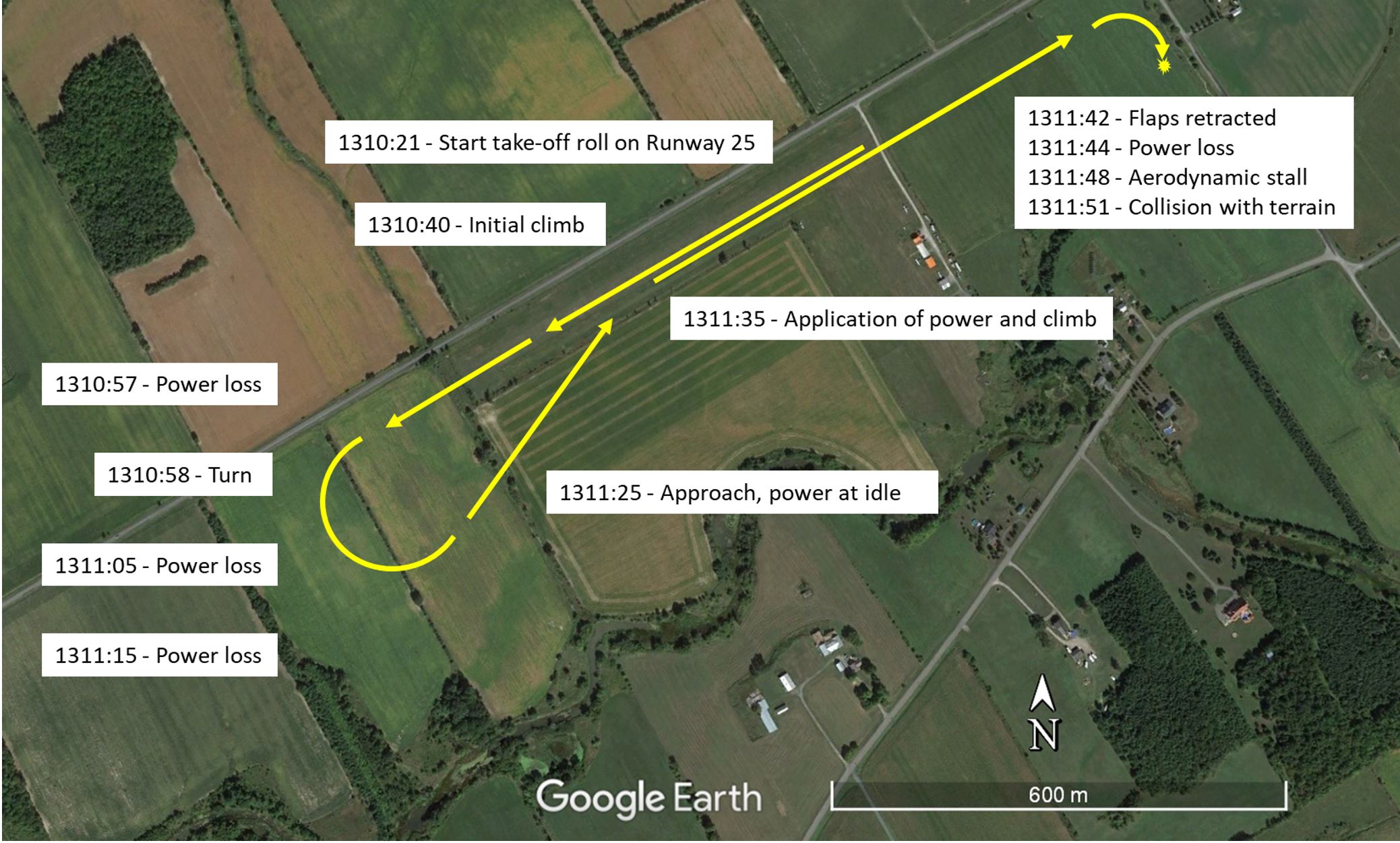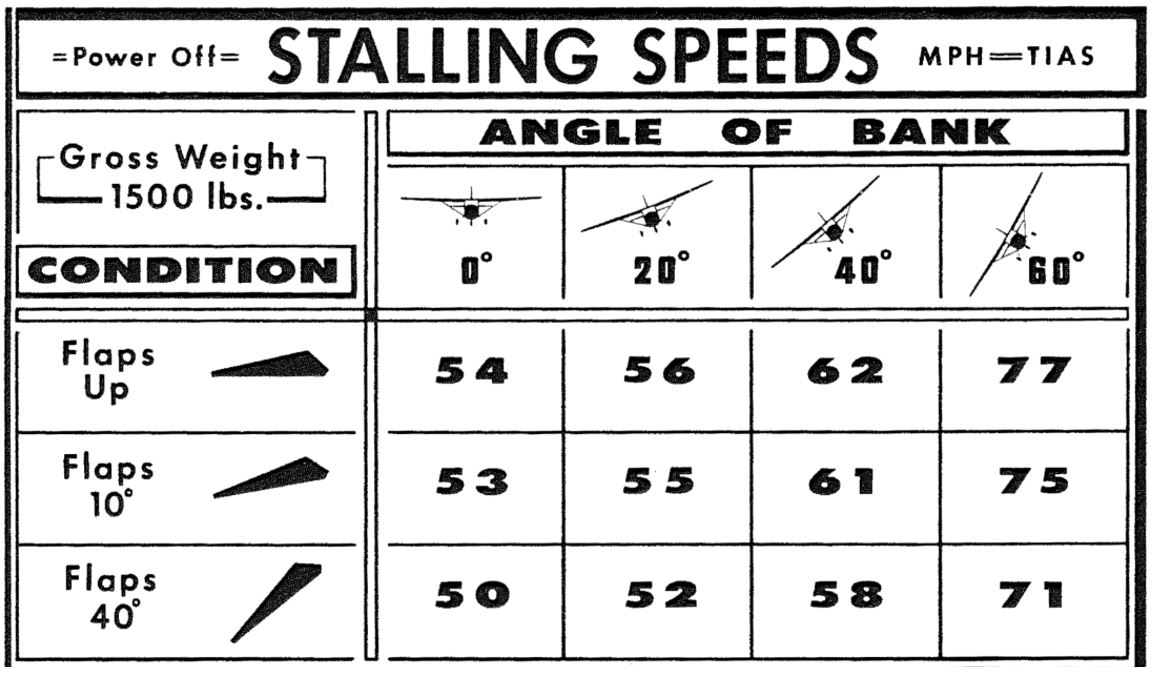Fuel exhaustion and collision with terrain
Privately registered
Cessna 150B, C-GFFG
Alexandria Aerodrome, Ontario
The Transportation Safety Board of Canada (TSB) investigated this occurrence for the purpose of advancing transportation safety. It is not the function of the Board to assign fault or determine civil or criminal liability. This report is not created for use in the context of legal, disciplinary or other proceedings. See Ownership and use of content. Masculine pronouns and position titles may be used to signify all genders to comply with the Canadian Transportation Accident Investigation and Safety Board Act (S.C. 1989, c. 3).
History of the flight
On the morning of 26 July 2023, the 2 occurrence pilots met at Lachute Aerodrome (CSE4), Quebec, to conduct a daytime visual flight rules (VFR) flight. The purpose of the flight was for one pilot, who was a flight instructor, to provide instruction to the 2nd pilot on a conventional (tailwheel) airplane.
At 1014Footnote 1, the pilots pushed the aircraft to the fuelling station. They had planned to fuel the aircraft before departure; however, they encountered a delay because a fuel truck was replenishing the local fuel tank, so they elected to conduct the flight without adding fuel. At 1030, the privately registered Cessna 150B aircraft (registration C-GFFG, serial number 15059645) departed CSE4 and flew to Hawkesbury Aerodrome (CNV4), Ontario, where the 2nd pilot practiced takeoffs and landings. At approximately 1130, the pilots landed and shut down the aircraft. They then took off from CNV4 about 1 hour later and headed to Alexandria Aerodrome (CNS4), Ontario.
At 1255, the aircraft arrived at CNS4, completed 2 circuits, and landed on Runway 25. It was then repositioned for takeoff on the threshold of Runway 25. At 1310:57, shortly after taking off and when the aircraft was below 200 feet above ground level (AGL), the engine experienced a momentary partial power loss. The instructor pilot, who was seated in the right seat, took control of the aircraft and performed a low-level 180° left turn to conduct an approach to Runway 07. During the turn, the aircraft experienced 2 additional partial power losses (at 1311:05 and 1311:15). The aircraft banked steeply before re-aligning over and approximately half-way down the runway. At 1311:35, with less than 1000 feet of runway remaining, the instructor pilot reapplied power before the aircraft touched down and initiated a go-around.
At 1311:42, during the climb, when the aircraft was just below 100 feet AGL and as the airspeed fluctuated between 50 and 60 mph indicated airspeed, the flaps were retracted from the 10° position to the UP position. At 1311:44, the engine rpm decreased from 2450 to 1300 rpm. The instructor pilot began a steep right turn during which the airspeed decreased further and the bank angle increased to about 45°. At 1311:48, the aircraft entered an aerodynamic stall, continued to roll to the right, descended in a steep nose-down attitude, and collided with terrain (Figure 1).
The instructor pilot was fatally injured. The 2nd pilot was critically injured and was transported to the local hospital.
The aircraft was destroyed; there was no post-impact fire. The aircraft’s emergency locator transmitter activated, and the signal was received by Cospas-Sarsat and the Joint Rescue Coordination Centre in Trenton, Ontario.
Weather information
The weather was suitable for the VFR flight. At the time of the accident, and for several hours after the accident, very strong winds with gusts from the west-southwest were observed at CNS4.
Pilot information
Both pilots held the appropriate licences and ratings to conduct the occurrence flight in accordance with existing regulations.
The instructor pilot held a commercial pilot licence – aeroplane and a valid medical certificate. He also held ratings for single- and multi-engine landplanes and seaplanes. He held a Class 3 flight instructor – aeroplane rating and a Class 2 flight instructor – aeroplane – aerobatic rating. He had accumulated about 1120 total flight time hours. He also held a glider pilot licence.
The 2nd pilot held a private pilot licence – aeroplane and a valid medical certificate. He also held ratings for single-engine landplanes. The 2nd pilot had accumulated over 122 total flight time hours and 98.3 hours on the occurrence aircraft type (95.7 of those hours were on aircraft equipped with tricycle landing gear).
Accident site and wreckage examination
The aircraft impacted the ground in a near-vertical, nose-down attitude and was destroyed. The aircraft systems were examined to the degree possible, and no indication of a malfunction was found. The flaps were determined to be in the UP position. There were no signs of a fuel leak or fuel contamination; 2.7 U.S. gallons of fuel remained on the aircraft.
The engine was disassembled and examined. There were no signs of a catastrophic engine failure or of mechanical failure of any major engine components.
The aircraft was equipped with 4-point safety belts, each consisting of a lap strap and shoulder harness, which both pilots were wearing. The shoulder harnesses were not equipped with an inertia reel; to tighten the harness, the user had to pull down on the buckle. However, once the harness is tightened, movement of the user’s arms can become restricted, and some areas of the cockpit and instrument panel could be out of reach. A video recording of the occurrence flight taken from inside the cockpit showed that the instructor pilot’s shoulder harness was attached very loosely over the shoulders throughout the flight.
Aircraft information
The Cessna 150B aircraft is a 2-seat, single-engine, piston aircraft with a fixed tricycle landing gear. The occurrence aircraft was manufactured in 1962 and was later converted to a conventional landing gear. A personal video camera was mounted on board and captured the flight from CNV4 to CNS4. The video showed the cockpit instruments and the pilots.
According to the owner’s manual, the aircraft’s power off stall speed with flaps at 10° is 53 mph.Footnote 2 With flaps in the UP position, the stall speed increases to 54 mph with 0° bank, 62 mph with 40° bank, and 77 mph with 60° bank (Figure 2).
The aircraft was equipped with a stall warning system. As described in the owner's manual,
[t]he stall warning indicator is an electric horn, controlled by a transmitter unit in the leading edge of the left wing. […] In straight-ahead and turning flight, the warning horn will sound 5 to 10 MPH ahead of the stall [speed].Footnote 3
In this occurrence, the stall warning horn sounded as the aircraft was approaching Runway 07 at CNS4, after the low-level 180° turn; however, it did not sound before the stall and subsequent collision with terrain. The investigation could not determine why the warning horn did not sound before the accident.
Fuel considerations
The aircraft owner’s manual requires pilots to visually check the fuel quantity in the tanks and to confirm this amount by checking the fuel quantity indicators. More specifically, step 1(b) of the exterior inspection states, “Turn on master switch and check fuel quantity indicators”Footnote 4 and step 4(c) states, “Remove fuel tank cap and check fuel level for agreement with gage [sic] reading. Secure cap.”Footnote 5
A common practice is to measure the actual amount of fuel by inserting a properly calibrated fuel dip stick in each tank. The aircraft’s fuel dip stick had been broken for some time and was no longer available. The investigation determined that pilots operating this aircraft rarely, if ever, used a dip stick to measure the fuel in the tanks. Instead, they either conducted a visual inspection of the fuel levels in the fuel tanks or relied on the fuel quantity indicators.
The total usable fuel for the occurrence aircraft was 22.5 U.S. gallons (11.25 U.S. gallons per tank), and the unusable fuel was 3.5 U.S. gallons (1.75 U.S. gallons per tank).
The fuel quantity indicator is marked E for empty, ½ for half full, and F for full, with graduation marks at the ¼ and ¾ points. The fuel quantity indicator readings from the last flight before the day of the occurrence were estimated at ½ tank and slightly below ½ tank. If these readings were accurate, this would equate to approximately 5.6 U.S. gallons in one tank and slightly less than 5.6 U.S. gallons in the other tank.
As discussed in a 2-part safety review of the Cessna 150 published in Flying in Ireland, the fuel gauges in this aircraft model have been known to be inaccurate and unreliable.Footnote 6,Footnote 7 In addition, the TSB has investigated previous occurrences involving inaccurate fuel gauges in aircraft with similar gauges.Footnote 8
In this occurrence, the recorded video from the personal video camera showed that the fuel quantity indicators displayed similar indications at 1236 (Figure 3), when the aircraft departed CNV4, and at 1311 (Figure 4), just before the accident.
For a daytime VFR flight, the Canadian Aviation Regulations require that the aircraft carries sufficient fuel “to fly to the destination aerodrome and then to fly for a period of 30 minutes at normal cruising speed.”Footnote 9
The aircraft was not refuelled before the occurrence and had only the remaining fuel from the previous flight on board.
Post-occurrence fuel calculations indicate that, given the weight of the occupants and cargo on board, the aircraft was likely overweight by as much as 69 pounds at the time of departure from CSE4. The estimated fuel at the time of departure from CSE4 likely would not have been sufficient to complete the flights that were conducted, not to mention maintaining a 30-minute reserve.
Aerodynamic stall in a turn
An aerodynamic stall occurs when the wing’s angle of attack exceeds the critical angle at which the airflow begins to separate from the wing. The speed at which a stall occurs is related to the load factor of the manoeuvre being performed. The load factor is defined as the ratio of the aerodynamic load acting on the wings to the aircraft’s gross weight and represents a measure of the stress (or load) on the structure of the aircraft.
In straight and level flight, lift is equal to weight. In a banked level turn, however, greater lift is required. It can be achieved, in part, by increasing the angle of attack (by pulling back on the stick/elevator control), which increases the load factor. As the load factor increases with bank angle, there is a corresponding increase in the speed at which the stall occurs. A stall from a steep bank angle (greater than 30°) can result in one wing stalling before the other, leading to a spin and the aircraft rapidly losing altitude.
Engine failure or partial power loss after takeoff
The 1962 Cessna 150B Owner’s Manual did not include an emergency procedures section. In 1970, an emergency procedures section was added to the owner’s manual and included a procedure for an Emergency Landing Without Engine Power. In 1975, the section was amended with a procedure for an Engine Failure After Take-Off that stated the following:
Prompt lowering of the nose to maintain airspeed and establish a glide attitude is the first response to an engine failure after take-off. In most cases, the landing should be planned straight ahead with only small changes in direction to avoid obstructions. Altitude and airspeed are seldom sufficient to execute a 180° gliding turn necessary to return to the runway.Footnote 10
In this occurrence, the instructor pilot increased the angle of bank significantly in the direction of the runway after losing engine power shortly after takeoff. Many fatal accidents have resulted from pilots attempting this manoeuvre, which often leads to a stall or loss of control at low altitude when trying to realign the aircraft with the runway. When faced with an immediate need to land due to a mechanical issue during takeoff, pilots must decide between a forced landing, potentially in an unsuitable location with risks of aircraft damage and personal injury, or attempting a 180° turn back to the departure point.
Transport Canada’s Flight Training Manual states:
Numerous fatal accidents have resulted from attempting to turn back and land on the runway or aerodrome following an engine failure after take-off. As altitude is at a premium, the tendency is to try to hold the nose of the aircraft up during the turn without consideration for airspeed and load factor. These actions may induce an abrupt spin entry. Experience and careful consideration of the following factors are essential to making a safe decision to execute a return to the aerodrome:
- Altitude.
- The glide ratio of the aircraft.
- The length of the runway.
- Wind strength/ground speed.
- Experience of the pilot.
- Pilot currency on type.Footnote 11
In addition to this Transport Canada guidance, international agencies, including the Federal Aviation Administration (FAA) of the United States and Australian Transport Safety Bureau (ATSB), also provide guidance that emphasizes the significance of correct manoeuvring during engine failures following takeoff.
An FAA safety article recommends that 180° turns be avoided and instead offers that pilots should select the best available landing area within an arc of about 60° left and right of aircraft heading and resist the temptation to turn back to the airfield.Footnote 12
The ATSB published a safety report that examined a partial power loss after takeoff. The report provides 3 options or decisions to make when faced with a partial power loss after takeoff: forced or precautionary landing within the aerodrome, beyond the aerodrome, or turning back towards the aerodrome. While the report does not select one option over another, it provides key messages focussing on pre-flight checks, planning, and considerations for maintaining aircraft control.Footnote 13
Safety messages
Pilots are reminded to ensure there is sufficient fuel on board, including reserves, for their intended flight, and to continuously monitor fuel levels during the flight.
It is important that pilots have pre-departure plans for handling emergencies such as an engine failure during takeoff. These plans should consider factors such as pilot experience, terrain, altitude, glide ratio, wind conditions, and available landing options.
This report concludes the Transportation Safety Board of Canada’s investigation into this occurrence. The Board authorized the release of this report on . It was officially released on .



